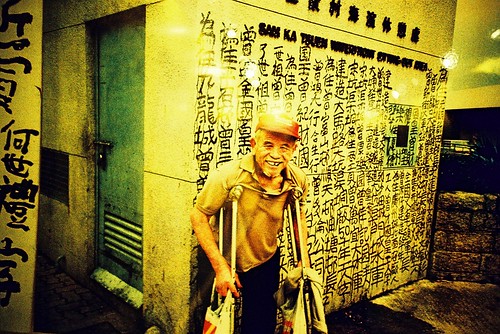


 Xu Bing’s Square Word Calligraphy and Square Word Calligraphy Classroom. Britta Erickson: “Square Word Calligraphy is a new kind of writing, almost a code, designed by Xu Bing. At first glance it appears to be Chinese characters, but in fact it is a new way of rendering English. Chinese viewers expect to be able to read it but cannot. Western viewers, however, are surprised to find that they can read it. Delight erupts when meaning is unexpectedly revealed.”
Xu Bing’s Square Word Calligraphy and Square Word Calligraphy Classroom. Britta Erickson: “Square Word Calligraphy is a new kind of writing, almost a code, designed by Xu Bing. At first glance it appears to be Chinese characters, but in fact it is a new way of rendering English. Chinese viewers expect to be able to read it but cannot. Western viewers, however, are surprised to find that they can read it. Delight erupts when meaning is unexpectedly revealed.”


A Book From the Sky by Xu Bing (徐冰), 1987-1991. “An installation that took Xu Bing over four years to complete, A Book from The Sky is comprised of printed volumes and scrolls containing four thousand ”false” Chinese characters invented by the artist and then painstakingly hand-cut onto wooden printing blocks.”
 United Nations – China Monument: Temple of Heaven, 1998, by Gu Wenda (谷文达). “a site-specific installation commissioned by the asia society for “inside out“, PS1 contemporary art center, new york city, usa, 1998 . an entirely human hair made temple of pseudo-chinese, english, hindi, arabic and synthesized english-chinese, chinese ming dynasty’s furniture tv monitors, a video film heaven.”
United Nations – China Monument: Temple of Heaven, 1998, by Gu Wenda (谷文达). “a site-specific installation commissioned by the asia society for “inside out“, PS1 contemporary art center, new york city, usa, 1998 . an entirely human hair made temple of pseudo-chinese, english, hindi, arabic and synthesized english-chinese, chinese ming dynasty’s furniture tv monitors, a video film heaven.”


DD, Confucius (2005) and O, Lao Tzu (2004) by Roman Verostko, from the Pearl Park Scriptures. Sections of the Legge translations of The Analects and the Tao Te Ching. “Each work presents a colorful drawing accompanied with lines of glyphs that read from left to right. An “alphabet” of glyphs was generated for each text in this exhibition.” The texts are converted into algorithms and a computer guided pen plotter draws the image and glyphs.

 Tsang Tsou-Chio (曾灶财) died last July. He spread calligraphy graffiti across Hong Kong, and was dubbed the “King of Kowloon”.
Tsang Tsou-Chio (曾灶财) died last July. He spread calligraphy graffiti across Hong Kong, and was dubbed the “King of Kowloon”.
A grubby man who looked like a tramp and who many thought barking mad, Tsang spent five decades roaming the metropolis — often shirtless and on crutches — scrawling his idiosyncratic calligraphy on lamp-posts, walls, phone boxes, pedestrian underpasses and electrical boxes.
“To some extent he’s quite cuckoo,” said leading Hong Kong fashion designer William Tang, a longtime admirer of Tsang who used the graffiti as a motif for several clothing ranges.
“I started to look at the calligraphy carefully and found it’s not just a joke. It has some kind of power, which is very raw, very original,” Tang added
Some say Tsang’s Chinese-style calligraphy, peppered with obscenities and abuse toward Britain’s Queen Elizabeth — is naive and an eyesore. But its quintessential Hong Kong symbolism has inspired other artists, including local film-maker Fruit Chan, and has drawn international acclaim.
Tsang was often at odds with police, and most of his city work has been erased. But by 2003 he was at the Venice Biennale.